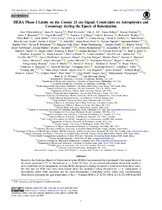| dc.description.abstract | Recently, the Hydrogen Epoch of Reionization Array (HERA) has produced the experiment’s first upper limits on
the power spectrum of 21 cm fluctuations at z ∼ 8 and 10. Here, we use several independent theoretical models to
infer constraints on the intergalactic medium (IGM) and galaxies during the epoch of reionization from these limits.
We find that the IGM must have been heated above the adiabatic-cooling threshold by z ∼ 8, independent of
uncertainties about IGM ionization and the radio background. Combining HERA limits with complementary
observations constrains the spin temperature of the z ∼ 8 neutral IGM to 27 KáTSñ 630 K (2.3 KáTSñ 640 K) at 68% (95%) confidence. They therefore also place a lower bound on X-ray heating, a previously unconstrained aspects of
early galaxies. For example, if the cosmic microwave background dominates the z ∼ 8 radio background, the new
HERA limits imply that the first galaxies produced X-rays more efficiently than local ones. The z ∼ 10 limits
require even earlier heating if dark-matter interactions cool the hydrogen gas. If an extra radio background is
produced by galaxies, we rule out (at 95% confidence) the combination of high radio and low X-ray luminosities of
Lr,ν/SFR > 4 × 1024 W Hz−1 M-1
yr and LX/SFR < 7.6 × 1039 erg s−1 M-1
yr. The new HERA upper limits
neither support nor disfavor a cosmological interpretation of the recent Experiment to Detect the Global EOR
Signature (EDGES) measurement. The framework described here provides a foundation for the interpretation of
future HERA results. | en_US |

